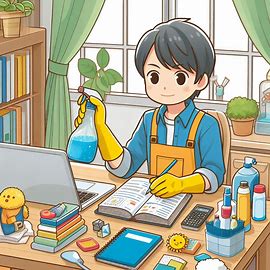
Introduction
Cleaning and organizing a home can feel overwhelming, especially when kids are involved. Their energy and curiosity often lead to messes faster than you can tidy up. However, involving children in cleaning and organizing is not only possible but also beneficial for their development and family harmony. This survival guide explores practical strategies, motivation techniques, and realistic approaches to making cleaning with kids manageable and even enjoyable.
1. Understanding the Challenges of Cleaning with Kids
1.1 Why Cleaning with Kids Is Different
Cleaning with kids isn’t just about getting the house spotless; it’s about balancing their developmental stages with household needs. Young children may lack the fine motor skills or attention span for complex tasks, while older kids might resist chores if they feel unfairly burdened.
When cleaning with kids, it’s crucial to:
-
Set age-appropriate expectations
-
Understand their learning style
-
Provide clear, simple instructions
By appreciating these differences, parents can reduce frustration and foster cooperation.
1.2 Common Pitfalls and How to Avoid Them
Many parents encounter resistance, unfinished chores, or even extra messes when involving kids. Common pitfalls include:
-
Assigning tasks that are too difficult or boring
-
Lack of structure or routine
-
No positive reinforcement or follow-up
Avoid these by breaking chores into small steps, establishing a cleaning routine, and praising effort, not just results.
2. Preparing Your Kids for Cleaning and Organizing
2.1 Setting Clear Expectations and Rules
Before diving into chores, have a family conversation to set ground rules. Kids need to understand:
-
Why cleaning is important (health, safety, respect for space)
-
What tasks are expected of them
-
When and how often cleaning will happen
Creating a simple chore chart can visually reinforce these rules and make expectations transparent.
2.2 Making Cleaning Fun and Engaging
To motivate kids, cleaning should feel less like a punishment and more like a game. Some ways to make cleaning enjoyable include:
-
Using timers to create “beat the clock” challenges
-
Playing upbeat music or songs while tidying
-
Offering small rewards or privileges for completed tasks
This approach transforms cleaning from a chore into a family activity that encourages teamwork.
3. Age-Appropriate Cleaning Tasks and Techniques
3.1 Toddlers and Preschoolers (Ages 2-5)
Young children can help with simple tasks that build habits and motor skills, such as:
-
Putting toys back in bins
-
Wiping low surfaces with a cloth
-
Sorting laundry by color
Use clear instructions and lots of encouragement to build confidence.
3.2 Elementary Age Kids (Ages 6-10)
Elementary children can handle more responsibility, including:
-
Making their bed
-
Vacuuming with a small vacuum
-
Taking out trash or recycling
Introduce them to organizing techniques like categorizing items and using labeled storage bins.
3.3 Preteens and Teens (Ages 11+)
Older kids can take on complex chores such as:
-
Cleaning bathrooms
-
Organizing closets and drawers
-
Helping prepare a cleaning schedule
Encourage independence while offering guidance and support as needed.
4. Organizing Strategies for Kid-Friendly Spaces
4.1 Creating Kid-Accessible Storage Solutions
Organizing kids’ rooms and play areas requires storage that they can use independently. Consider:
-
Low shelves and bins labeled with words or pictures
-
Clear containers for easy identification
-
Rotating toys to avoid clutter overload
These solutions empower kids to put things away themselves.
4.2 Using Visual Aids and Labels
Visual cues help children remember where items belong. Use:
-
Color-coded bins for different toy categories
-
Picture labels for younger kids who can’t read yet
-
Checklists to track cleaning progress
Visual aids reduce confusion and make organizing intuitive.
4.3 Decluttering Together: Teaching the Value of Letting Go
Decluttering is an important part of organizing. Teach kids to:
-
Sort toys and clothes into keep, donate, or discard piles
-
Reflect on what they actually use or enjoy
-
Understand the benefits of a tidy environment
This fosters decision-making skills and reduces future messes.
5. Maintaining Clean and Organized Spaces with Kids
5.1 Establishing Daily and Weekly Cleaning Routines
Consistency is key for maintenance. Set routines such as:
-
A nightly 10-minute tidy-up before bedtime
-
Weekly deep clean sessions with assigned roles
-
Family cleaning days for communal spaces
Routines create structure and set expectations for everyone.
5.2 Encouraging Responsibility and Ownership
Help kids take pride in their space by:
-
Letting them personalize their cleaning systems
-
Offering choices on which chores to do
-
Discussing the positive impact of a clean home
When kids feel responsible, they’re more likely to keep areas tidy.
5.3 Positive Reinforcement and Celebrating Progress
Celebrate achievements, big or small. Use:
-
Verbal praise and encouragement
-
Reward charts or tokens for consistent effort
-
Family rewards like a special outing after a successful clean-up
Positive reinforcement builds motivation and strengthens family bonds.
Conclusion: Turning Cleaning into Quality Family Time
Cleaning and organizing with kids doesn’t have to be a battle. With patience, clear communication, and creative approaches, you can transform chores into opportunities for learning, responsibility, and togetherness. Remember, perfection isn’t the goal—progress and cooperation are what truly matter.
What strategies have you found helpful when cleaning with your kids? Share your tips or challenges below—let’s support each other in creating happy, organized homes!